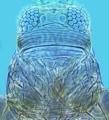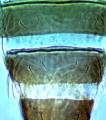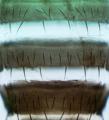Thrips hawaiiensis
Recognition data
Distinguishing features
Both sexes fully winged. Body brown, or sometimes bicolored with head and thorax paler than dark abdomen; legs yellowish; antennal segment III yellow; fore wing brown with base paler. Head wider than long; two pairs of ocellar setae; pair III stout, arising just outside ocellar triangle margins; postocular setae pairs I & III slightly shorter than ocellar setae pair III, pair II very small. Antennae variable, 8- or 7-segmented; III–IV with short forked sensorium; segments VII & VIII short. Pronotum with 2 pairs of long posteroangular setae; posterior margin with 3 pairs of setae. Mesonotum with lines of sculpture between and around campaniform sensilla near anterior margin. Metanotum with lines of sculpture longitudinal medially, transverse at anterior; median setae arising at anterior margin; campaniform sensilla present. Fore wing first vein with 3 setae on distal half; second vein with about 14 closely set setae; clavus with subapical marginal seta shorter than apical seta. Abdominal tergite II with 4 lateral marginal setae; tergites V–VIII with ctenidia present laterally, on VIII posteromesad to spiracles; tergite VIII with posteromarginal comb complete medially, microtrichia small and irregular, sometimes arising in groups; pleurotergites without discal setae. Sternite II with 2 pairs of marginal setae, 1–4 discal setae; sternites III–VII discal setae varying from 10 to 25, in a regular transverse row.
Male smaller and paler than female; tergite VIII with no marginal comb; sternites III–VII with transverse pore plate anterior to discal setae.
Related and similar species
The genus Thrips is the second largest genus in the Thysanoptera, and currently includes, worldwide, about 285 species. T. hawaiiensis is a member of an extensive Asian group of species (Palmer, 1992). It is very similar to T. florum Schmutz, although in that species the subapical seta on the fore wing clavus is longer than the apical seta. All members of genus Thrips lack ocellar setae I on the head, and they all have ctenidia on tergite VIII posteromesad to the spiracles. Other characters, such as number of antennal segments, number of setae on the fore wing veins, and number of discal setae on the sternites are variable between species (Nakahara, 1994; Mound & Masumoto, 2005).
Taxonomic data
Current valid name
Thrips hawaiiensis (Morgan)
Original name and synonyms
- Euthrips hawaiiensis Morgan, 1913: 3
- Thrips sulphurea Schmutz, 1913: 1011
- Thrips nigriflava Schmutz, 1913: 1012
- Thrips albipes Bagnall, 1914: 25
- Physothrips albipes Bagnall, 1916: 401
- Physothrips pallipes Bagnall, 1916: 400
- Bregmatothrips theifloris Karny, 1921: 66
- Thrips versicolor Bagnall, 1926: 108
- Thrips pallipes Bagnall, 1926: 110
- Physothrips emersoni Girault, 1927: 2
- Thrips io Girault, 1927: 351
- Thrips partirufus Girault, 1927: 1
- Physothrips lacteicolor Girault, 1928: 1
- Physothrips marii Girault, 1928: 2
- Taeniothrips eriobotryae Moulton, 1928: 297
- Physothrips darci Girault, 1930: 1
- Thrips imitator Priesner, 1934: 267
- Taeniothrips florinatus Priesner, 1938: 489
- Taeniothrips rhodomyrti Priesner, 1938: 492
Family placement
Thripidae, Thripinae
Biological data
Life history
Breeding in flowers
Host plants
Highly polyphagous, but often associated with Gardenia (Rubiaceae).
Tospoviruses vectored
None
Crop damage
None
Distribution data
Area of origin
Probably southern Asia or the Pacific.
Distribution
Widespread across Asia and the Pacific Islands, also Jamaica and some southern States of the USA, including California.










